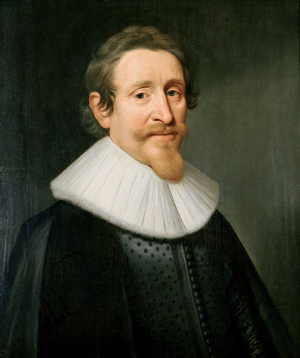
Hugo Grotius (1583-1645)
[Portrait by Michiel Jansz van Mierevelt] |
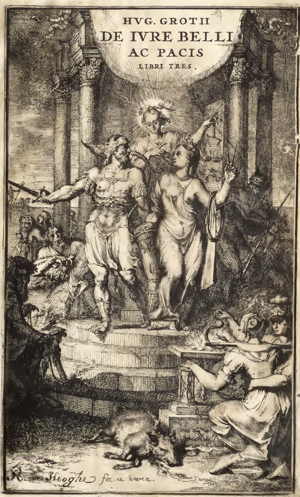 |
| Hugo Grotius (1583-1645) | [Title page of the 1670 Amsterdam edition of The Rights of War and Peace] |
Introduction
The following remarks are by David J. Hill, Assistant Secretary of State of the United States, from his Introduction to the 1901 edition of Grotius' The Rights of War and Peace [HTML]:
HUGO GROTIUS, to use the Latin form of his name by which he is best known, or Hugo de Groot as he is called in Holland, descended from a race of scholars and magistrates, was born at Delft, on April 10th, 1583. His family history has been related with much detail by De Burigny, in his "Vic de Grotius," published in French at Amsterdam in 1754; and by Vorsterman van Oyen, in his "Hugo de Groot en Zijn Gesclacht," a complete genealogy in Dutch, published at Amsterdam in 1883, which gives the descendants of Grotius down to the present generation. His origin is traced from a Frenchgentleman, Jean Cornets, who took up his residence in The Netherlands in 1402. His descendant, Cornelius Cornets, married the daughter of a burgomaster of Delft on condition that the future children of this marriage should bear the name of their mother's family, in order to perpetuate the distinction which it had achieved. The maternal name imposed by Cornelius Cornets's Dutch father-in-law, Dirk van Kraayenburg de Groot, was de Groot, meaning the Great, and is said to have been bestowed for signal services rendered to his country by the first who had borne it four hundred years before. From this marriage sprung a Hugo de Groot, distinguished for his learning in Greek, Latin, and Hebrew and five times burgomaster of his native city. His eldest son, Cornelius, was a noted linguist and mathematician who studied law in France and received high office in his own country, afterward becoming a professor of law and many times rector of the University of Leyden. Another son, John de Groot, the father of Hugo Grotius, studied there under the famous Lipsius, who speaks of him with the highest commendation. Four times burgomaster of Delft, John de Groot became curator of the University of Leyden, a position which he filled with great dignity and honor.
In his earliest years the young Hugo gave evidence of marked and varied ability. At eight he wrote Latin verses which betrayed poetic talent; at twelve he entered the University where he became a pupil of that prince [5] of scholars, Joseph Scaliger, who directed his studies; and at fifteen he defended "with the greatest applause" Latin theses in philosophy and jurisprudence. His fame as a prodigy of diversified learning spread far and wide, and great scholars declared they had never seen his equal.
Grotius had won celebrity even in foreign lands when, in 1600, at the age of seventeen, he was admitted to the bar. The youthful prodigy had already accompanied the Grand Pensionary, John of Oldenbarneveld on a special embassy to France, where he was presented to Henry IV., who bestowed upon him his portrait together with a gold chain, and graciously called him "The Miracle of Holland." At Orleans he was made a Doctor of Laws.
Married in 1609 to Marie van Reigersberg, whose devotion was worthy of his deep affection, and loaded with public honors, having been named the official historian of the United Provinces and the advocate-general of two provinces, Holland and Zeeland, Grotius set his hand to a work entitled "Mare Librum," in which he defended the freedom of the sea and the maritime rights of his country against the arrogant pretensions of the Portuguese in suppressing the commerce of other nations in Eastern waters,—a treatise destined to become still more celebrated in the history of international law by Selden's reply, "Mare Clausum," written in 1635. Next, turning his attention to the history of The Netherlands, he devoted himself for a time to his "Annals of the War of Independence."
In 1613, Grotius added to his laurels as poet, jurist, and historian by entering the field of politics, and he was appointed Pensionary of Rotterdam upon the condition that he should continue in office during his own pleasure. It was during a visit to England upon a diplomatic mission in this same year that he met the great scholar Isaac Casaubon, who said in a letter to Daniel Heinsius: "I cannot say how happy I esteem myself in having seen so much of one so truly great as Grotius. A wonderful man! This I knew him to be before I had seen him; but the rare excellence of that divine genius no one can sufficiently feel who does not see his face and hear him speak. Probity is stamped on all his features."
Closely related by personal friendship as well as by his official duties to the Grand Pensionary, John of Oldenbarneveld, Grotius was destined to share with that unfortunate patriot the proscription and punishment which [6] Maurice of Orange visited upon the two confederates in the defense of religious tolerance. Risking all as the apostles of peace, they were soon condemned to be its martyrs. Oldenbarneveld, having incurred the bitter hatred of the Stadtholder, was condemned to death by decapitation on May 12th, 1619. Grotius, less offensive to Maurice on account of his youth and his gracious personality, was sentenced six days later to perpetual imprisonment. On the 6th of June, 1619, he was incarcerated in the fortress of Loevestein.
Rigorously treated at first, his docility and resignation soon won the respect and affection of his keepers. Writing materials and books were in time accorded him, and finally, on condition that she would continue to share his captivity, he was granted the presence of his wife. The studious prisoner and his devoted companion completely disarmed all suspicion of an intention to escape, and the ponderous chest in which books came and went continued to bring periodic consolation to the mind of the busy scholar. A treatise on the truth of the Christian religion, a catechism for the use of his children, a digest of Dutch law, and other compositions served to occupy and alleviate the weary months of confinement, until one day when the time seemed opportune Madame Grotius secretly inclosed her husband in the great chest and it was borne away by two soldiers. Descending the stone steps of the prison the bearers remarked that the trunk was heavy enough to contain an Arminian, but Madame Grotius's jest on the heaviness of Arminian books smoothed over the suspicion, if one was really entertained, and the great jurist was sent in the chest safe to Gorcum, attended by a faithful domestic, where in the house of a friend the prisoner emerged without injury and in the guise of a stone mason hastened to Antwerp. From Antwerp he took refuge in France, where he arrived in April, 1621, and was joined by his faithful wife at Paris in the following October.
The bitterness of exile was now to be added to the miseries of imprisonment, for Grotius was not only excluded from The Netherlands, but in extreme poverty. His letters reveal his anguish of spirit at this period, but a generous Frenchman, Henri de Même, placed his country house at Balagni at his disposition, and there, supported by a small pension, which Louis XIII had graciously accorded him, though irregularly and tardily [7] paid, Grotius commenced his great work, "De Jure Belli ac Pacis," in the summer of 1623.
Much speculation has been indulged in regarding the causes which led to the composition of this masterpiece, but a recent discovery has rendered all this superfluous, as well as the ascription of special merit to the Counselor Peyresc for suggesting the idea of the work. It is, indeed, to the pacific genious of Grotius more than to all other causes that the world owes the origin of his great work; for it sprang from his dominant thought, ever brooding on the horrors of war and the ways of peace, during more than twenty years, and never wholly satisfied till its full expression was completed.
In the winter of 1604, there had sprung out of his legal practice the idea of a treatise entitled "De Jure Praedae," fully written out, but never printed by its author. The manuscript remained unknown by all his biographers until it was brought to light and printed under the auspices of Professor Fruin at The Hague in 1868. This interesting document proves that not only the general conception but the entire plan and even the arrangement of the "De Jure Belli ac Pacis" were in the mind of Grotius when he was only twenty-one years of age. The difference between the earlier work and the later is chiefly one of detail and amplification, the difference which twenty years of reading, experience, meditation and maturity of faculty would inevitably create.
The curious may find in his letters the almost daily chronicle of his progress with his book to the time of its publication after excessive labors lasting more than a year. In March, 1625, the printing of the first edition, which had occupied four months, was completed and copies were sent to the fair at Frankfort. His honorarium as author consisted of two hundred copies, many of which he presented to his friends. From the sale of the remainder at a crown each, he was not able to reimburse his outlay. In the following August he wrote to his father and brother that if he had their approbation and that of a few friends, he would have no cause for complaint but would be satisfied. Louis XIII, to whom the work was dedicated, accepted the homage of the author and a handsomely bound copy, but failed to exercise the grace customary with monarchs by according a gratification. At Rome, the treatise was proscribed in the index in 1627. Almost penniless and [8] suffering from his protracted toil, Grotius seemed destined to neglect and oblivion, yet from his exile he wrote to his brother: "It is not necessary to ask anything for me. If my country can do without me, I can do without her. The world is large enough…."
Invited to enter the service of France by Richelieu, Grotius would not accept the conditions which the Cardinal wished to impose,—such at least is the inevitable inference from his letters. His pension was not paid and his circumstances became so serious that one of his children had but a single coat. At length, pushed to the utmost extremity of want and instigated by his energetic wife, Grotius resolved to return to Holland. Driven from Rotterdam to Amsterdam, where he hoped to settle down as a lawyer, the States General twice ordered his arrest and named a price for his delivery to the authorities. The new Stadtholder, Frederick Henry, who, before succeeding his brother Maurice, had written kindly to Grotius after his escape from imprisonment, now approved his proscription. Abandoned by his prince as well as by his countrymen, Grotius once more turned his face toward exile and set out for Hamburg.
Texts in the Collection
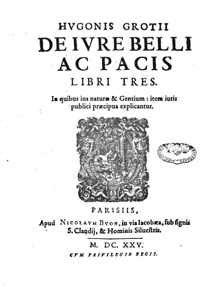 |
The first edition published in Paris in 1625: Hugonis Grotii, De iure belli ac pacis libri tres, In quibus jus Naturae Gentium, item juris publici precipua explicantur. Parisiis, Apoud Nicolavm Bvon, in via Icabaea, sub signis S. Claudij, Hominis Siluestris. M. DC. XXV. |
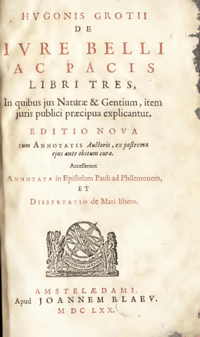 |
A new edition of 1670 published in Amsterdam, with annotations and a version of Mari libero (The Free Seas), and two etchings - one of Grotius and an allegorical title page by Romeyn de Hooghe (1645 – 1708) showing Justice presiding over the coming together of War and Peace. [See below for details] |
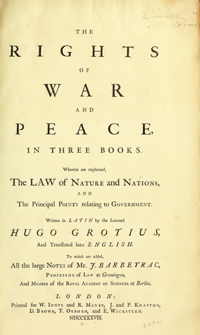 |
The authoritative 18th century edition was produced by Jean Barbeyrac, Professor of Law at Groningen, with copious notes. This edition was translated into English in 1738: Hugo Grotius, The Rights of War and Peace, in Three Books. Wherein are explained, the Law of Nature and Nations, and the Principal Points relating to Government. Written in Latin by the Learned Hugo Grotius, Hugo, and translated into English. To which are added all the large Notes by Mr. J Barbeyrac, Professor of Law at Groningen, and Member of the Royal Academy of Sciences at Berlin. (London : Printed for W. Innys and R. Manby, J. and P. Knapton, D. Brown, T. Osborn, and E. Wicksteed. MDCCXXXVIII). |
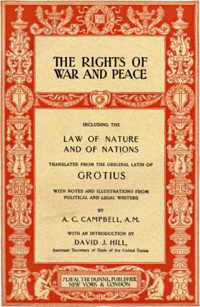 |
An edition published just after the International Peace Conference at The Hague July 4th, 1899, with an introduction by David J. Hill, Assistant Secretary of State of the United States. It has been slightly abbreviated and does not contain the important Prolegomena to the work (which can be found in the 1925 ed.): The Rights of War and Peace, including the Law of Nature and of Nations. Translated from the Original Latin of Grotius. With Notes and Illustrations from Political and Legal Writers by A.C. Campbell, A.M. With an Introduction of David J. Hill, Assistant Secretary of State of the United States (New York: M. Walter Dunne, 1901). It also had the following dedication: To the Memory of Hugo Grotius in Reverence and Gratitude from the United States of America on the Occasion of the International Peace Conference at The Hague July 4th, 1899. |
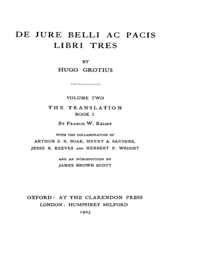 |
The 1925 edition published by the Carnegie Institution and was part of the The Classics of International Law. Edited by James Brown Scott, President of the Institute of International Law, President of the American Institute of International Law: De jure belli ac pacis libri tres, by Hugo Grotius. (Oxford: At the Clarendon Press, 1925).
Because of the complexity of the footnotes and marginal notes we have only put the "Prolegomena" in HTML |
Illustrations from the 1670 Amsterdam edition
The frontispieces for this edition included an etching of Hugo Grotius and another by by Romeyn de Hooghe (1645–1708) showing Justice presiding over the coming together of War and Peace.
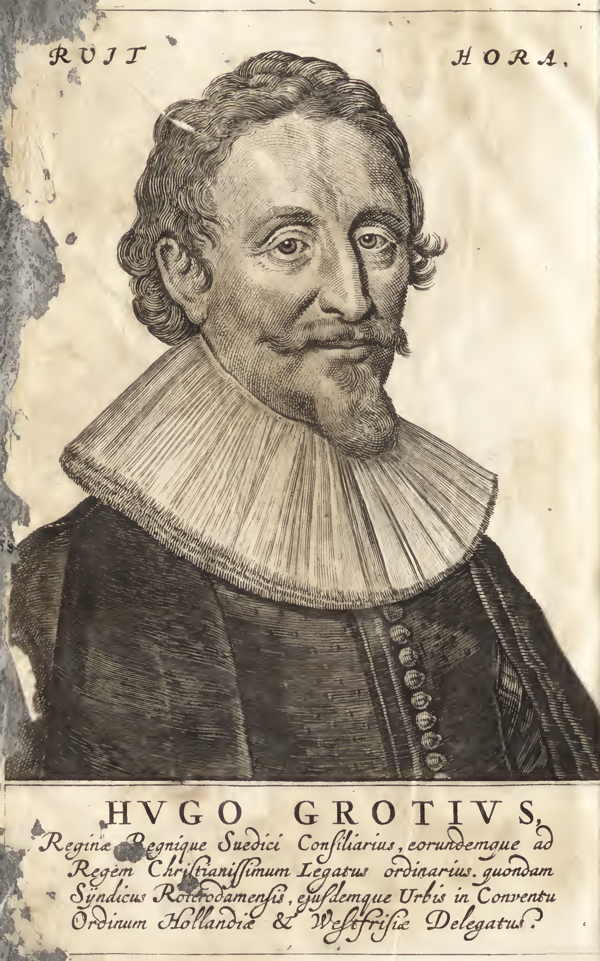

[the largest version we have is 1800 x 3050 px]
Some thoughts on the meaning of the illustration.
Standing on a round temple is Justice (she holds the scales of justice in her right hand) above Mars (war) who holds a sword in his right hand, next to whom is Peace or Abdundance who holds a compass in her left hand (to measure out quantities), over which is draped a snake which is biting its own tail in a circle (a symbol of eternity), and who holds in her right hand the cornucopia (the horn of plenty). On either side of them and slightly behind are some shadowy figures whose meaning is not clear. Mars' sword points to the left and in the distance is Nepture with his trident and his chariot pulled by horses. Since Holland and England were both aspiring sea powers this may be a reference to this fact. At the foot of the temple at the right are two figures, a man wearing a helmet who is holding another snake over a fire with his right hand (perhaps here a symbol of evil) and with his left holding a woman around her waste; she is a peasant girl who is wearing a bonnet and a yoke around her shoulders (a symbol of submission) and in her left hand an hour glass (a symbol of the passage of time and of death). At the left is a bearded man in the shadows who is also holding a snake over a fire. At the very bottom of the picture is a dead boar (a symbol of lust and ferocity) which has been sacrificed.
